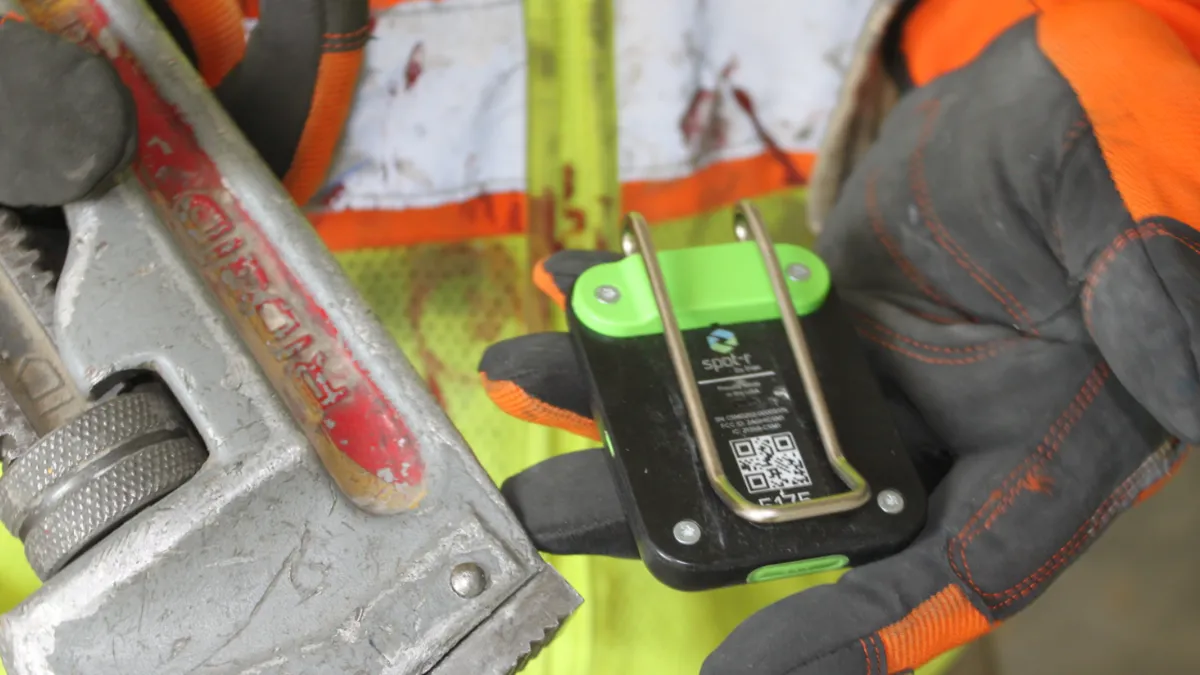When a Gilbane Building Co. employee spotted a gas pipe leak on his construction project, he only had to click a button to instantly alert the entire site. A digital dashboard activated 80-decibel alarms across the jobsite and on each worker's wearable Spot-r clip.
A Gilbane official said the site was quickly cleared and managers were able to double check that all workers were out safely via a dashboard, which tracked the location of everyone based on information transmitted from their clips.
The Providence, Rhode Island-based contractor began using Triax’s Spot-r clip on some jobsites about two years ago. The wearable device uses radio frequency identification (RFID) technology to track employees and subcontractors when they are within range of the system's standalone sensors.
The Spot-r unit automatically goes off if a worker falls, and employees can push it if they — or a nearby co-worker — get hurt or notice a hazardous situation needing immediate attention.
“Our original goal was to provide an alert of a fall, and not from significant heights but even small falls of like 2 feet or so, which could mean someone jumped off a truck or hopped to a lower scaffold,” said Rebecca A. Severson, Gilbane’s vice-president, corporate director of safety. “These small instances can still cause an injury.”
Each clip gets assigned to a specific person, so when there is an emergency, medics know exactly who they are looking for once they reach the approximate location shown on the system dashboard. Severson said someone responds every time a fall alert goes off. A significant fall — 6 or more feet — results in rapid response from a medical team. But even alerts indicating a minor height change prompt a visit from someone on the site.
Severson said this continuous monitoring is changing the culture on the jobsite and bringing up more conversations around safety.
“Within a few seconds of any incident, we are able to check it out and then we can have the conversation about a less-safe behavior like jumping from scaffolding to scaffolding to prevent future instances, which in turn leads to less injuries,” she said.
Beyond safety, managers use the devices to track crews working in certain areas to help plan assignments more efficiently. For example, if managers assign a plumbing crew to the third floor one week, they can see if the plan matched the work getting done. If some plumbers ended up staying in the previous week’s assigned area, managers can investigate why and use the information to plan more efficiently going forward.
The industry's move to wearable technology for safety and efficiency is growing. According to GlobalData, the market for wearable technology was nearly $23 billion in 2018, a number expected to reach an estimated $54 billion in the next three years.
Challenges lead to changes
Incorporating the device on Gilbane jobsites presented plenty of challenges. For instance, the clips often get lost, because they can’t be tracked once taken off site. The biggest hurdle, according to Severson, involves articulating to workers how they work and why they need to wear them.
“We work with supervisors before each job starts to communicate how and why we’re using the clip,” she said. “It’s all about their safety and protection — it’s not Big Brother. And it doesn’t invade their privacy, because nothing gets tracked once they leave the site.”
In the years since Gilbrane rolled out the Spot-r clip, the firm's safety leaders have worked with the manufacturer to expand the device’s use.
“Triax created an advisory committee that reports on challenges and suggests changes,” said Severson. “Each year we give Triax feedback and they improve the clip.”
The building evacuation system was one of the additional protections suggested by Gilbane. Other ideas stemming from the contractor include setting a virtual barrier and a site lockdown feature. Locking down the site keeps the public away from potential harm until approved personnel approved can unlock gates.
The evacuation feature also allows Gilbane to set up exclusion zones. These virtual barriers help ensure that physical barriers around certain hazard zones aren’t ignored. Only certain people wearing an assigned clip can cross the virtual barriers without setting off an alarm.
A more recent feature tested by the contractor allows supervisors to monitor if employees' training and credentials match the machines they operate. Supervisors receive an alert if someone’s clip gets within range of a machine that he or she isn't certified to operate. Sometimes it’s just a matter of updating the system, but the company hopes to avoid a more serious incident by knowing if workers try to operate equipment they aren’t trained to use, Severson said.





















